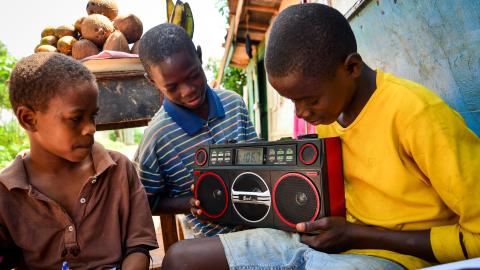
Education in emergencies
Education is a fundamental right of all children, but children in emergencies are constantly denied this right - in 2015 humanitarian emergencies and protracted crises disrupted the education of more than 80 million children.
Education in emergencies needs to be a prioritised as an intervention in the immediate and ongoing phases of a disaster. World leaders have recognised that education in emergencies is important, but now we must hold them to account to deliver on their promises. World Vision calls on these leaders to support the Education Crisis Platform and commit to reaching $1.5 billion in dedicated funding for Education in Emergencies by 2020. To ensure education is equitable and inclusive World Vision advocates that affected communities are consulted in the design of education in emergencies programmes, including children and youth.
World Vision’s Commitment
- World Vision will aim to reach 20% of all affected children when we respond to conflict and natural disasters. We will do this by prioritising child protection and education in emergencies as lifesaving interventions; investing in protection systems strengthening; empowerment of children and youth as agents of change; advocacy and research and learning to strengthen the evidence base for the most effective humanitarian interventions; and by investing in a global campaign to address violence against children including in natural disasters and protracted crises.
Education is life-saving
Education can be a life-saving intervention: it provides a safe place for children to learn and play, provides protection from further violence and exploitation such as forced labour, sexual exploitation and abuse, early child marriage, and recruitment into armed groups, and other life-threatening, often criminal activities.
Education in emergencies provides children, and their communities, with life-saving information, including disaster preparedness, awareness of their rights and responsibilities, landmine and earthquake awareness, hygiene, and other survival skills specific to their context.
Guaranteeing continuity of education in emergencies significantly reduces the social and economic cost, and physical and psychosocial impact, on children.
Read More
Let Us Learn: Delivering adaptive education and protection in emergencies programmes in the Kurdistan Region of Iraq. A case study.
In emergencies access to continuous, equitable, inclusive and quality education is life-sustaining.
Education is an important tool to provide children and communities with a sense of normalcy following a disaster, instilling hope and mitigating the psychosocial impact of violence and displacement.
To ensure continuity of education in a humanitarian response World Visions works with communities and all levels of governments to ensure children have access to formal education.
In humanitarian situations where children cannot access education World Vision works with a variety of partners to implement non-formal programmes that support re-entry into formal systems.
According to children, the long-term impacts of receiving an education help them rise above their current situations, care for their families, create financial resilience for their household, access better jobs with leadership positions, increase their knowledge and literacy and become good people.
Read More
New e-Learning education helps Syrian refugee children flourish. An article on our innovative e-Learning programme in Lebanon.
Outrage and optimisim: Education in emergencies is ready for a revolution. An opinion piece from Elika Dadestan, Education in Emergnecies Specialist, World Vision International
The economic and social cost of not providing education in emergencies is too high to ignore.
Education is a fundamental right of all children, but children in emergencies are constantly denied this right - in 2015 humanitarian emergencies and protracted crises disrupted the education of more than 80 million children (UNESCO, 2010)
Despite a record number of children affected by conflict, in 2013 only 2% of humanitarian funding went to education.
Children who experience frequent and/or continuous disruption to their education are more likely to remain out of school, enter into criminal activities and are more susceptible to exploitation.
The average refugee spends 17 years away from home. If a child is unable to access quality education during this time, they may be unable to achieve full self-reliance, becoming dependent on international assistance as an adult.
Read More
Download the full report, The Cost of Conflict for Children: Five years of the Syrian crisis
World Vision does not condone any form of violence affecting children in schools
World Vision endorses existing agreements and positions from UN bodies that hold perpetrators of violence against schools, and their governments, accountable.
Access to safe learning is important for the protection of students during conflict times. Even if there is no physical attack on schools, students and teachers, making education inaccessible or diminishing opportunities to learn can also be considered a violation of the right to education under international human rights law.
Disruption to formal education due to destruction or repurposing of education facilities, concern for safety, or forced displacement of communities is common in conflict contexts and has resulted in millions of primary and lower secondary school aged children being out of school.
Safe educational spaces provide stronger integration for other critical sectors such as health, nutrition, mental health and psycho-social support, resilience and life skills.